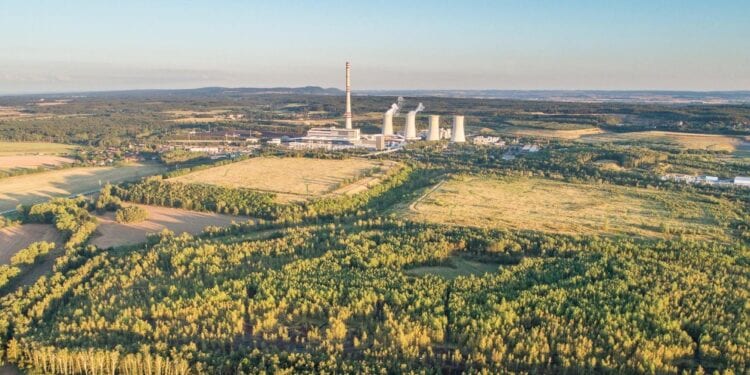Major Milestones Set To Be Reached In Early 2022
Euro Manganese Inc. (TSXV / ASX: EMN) says the company’s proposed Chvaletice Manganese Project in the Czech Republic remains right on track following the recent successful close of the second tranche of the company’s oversubscribed private placement of A$30 million.
The Project is designed to produce high-purity manganese products by reprocessing manganese-rich tailings from a decommissioned mine, located 90 km east of Prague in the Czech Republic.
Permitting process and Final Environmental and Social Impact Assessment move forward
The permitting process for the Project continues to build on five years of meaningful and constructive engagement with governments, regulatory agencies and local communities.
The company says it has benefitted from ongoing collaboration and support for the Project at various levels of the Czech Government, who approved the company’s application for investment tax credits on eligible project expenditures, and, in March 2020, issued a ruling under European Union’s Natura 2000, which determined that the Chvaletice Manganese Project is not expected to adversely impact endangered and protected species habitat.
Current permitting work is focused on producing a Final Environmental and Social Impact Assessment for the Project. Completing the assessment is the next step in the permitting process, following the successful initial public screening procedure of the Project’s Preliminary EIA by the Czech Ministry of the Environment in late 2020.
Based on the outcomes of these intensive community consultations and the initial Ministry of the Environment screening procedure, the Project has been well-accepted by stakeholders, with no critical concerns.
“The Project has received all necessary regulatory, permitting and tenure approvals to date in an expeditious way,” says Jan Votava, Managing Director of EMN’s Czech operation.
“We appreciate the support and professionalism of the Czech Government and regulatory authorities, and the collaborative and respectful attitude of local communities.”
Local groundwater has long been contaminated by the existing Chvaletice tailings deposits, which leach metals and salts into the underlying aquifer. Regulatory bodies that participated in the initial screening procedure have viewed the Project positively because it is designed to eliminate the longstanding source of water pollution and restore the site back to a more natural state.
Water management is an essential part of the project design. A comprehensive groundwater monitoring program has been in place since 2017 to establish benchmark data on the extent of the contamination. To date, 25 monitoring wells have been drilled, and the water is tested monthly. The Company is targeting the use of only recycled, contaminated and waste-water in its production process.
Demonstration Plant progressing well
Detailed design of the Chvaletice Manganese Project’s Demonstration Plant (DP) by the Changsha Research Institute for Mining and Metallurgy is progressing well, with 97% of equipment ordered and fabrication about to begin. The DP consists of six interconnected modules that will replicate the entire HPM production process to be used in the commercial operation of the Project.
At the Chvaletice Project site, planning work is underway for a revamp of two industrial buildings that were part of the original Chvaletice mining operation four decades ago. The buildings will be upgraded to house the DP modules. The permitting process for the building renovation and construction work is underway and targeted for completion in June/July 2021.
Definitive feasibility targeted for completion by Q1 2022
The Company continues to make solid progress on the definitive feasibility study, which is targeted for completion in the first quarter of 2022. To date, the study is tracking on schedule and on budget, with approximately 50% of physical progress complete as at the end of April 2021. The study is expected to provide the design, cost and scheduling details needed to arrive at a final investment decision and secure full financing for the Project.
Testing is underway to help optimize the design of processes including materials handling, solid/liquid separation, leaching, purification and crystallization.
Recent work on the site included a geotechnical drilling programme of 20 bore holes in both the mine site and process plant areas to quantify ground conditions required for the design of building foundations. Additionally, a groundwater pumping test is planned to determine the availability of contaminated ground water as a potential source of process make up water for the plant.
Market for high purity manganese products continues to grow
The final investment decision for the Chvaletice Manganese Project will also depend on securing offtake agreements with customers who want to purchase its high purity manganese products. As the only sizeable manganese resource in the European Union, the Project is in a strong strategic position.
Customer interest is increasing, and discussions continue with several potential offtakers of Chvaletice’s HPM products. “For many prospective customers, the Chvaletice Manganese Project ticks all the boxes,” says Euro Manganese CEO, Marco Romero.
“As a recycling project, we have the potential to be one of the world’s greenest sources of high purity manganese, which will help auto makers and battery manufacturers meet the EU’s increasingly stringent environmental standards.
“We expect to help the EU meet its decarbonisation goals, while cleaning up a longstanding source of water pollution and creating long-term local employment. There’s no other HPM production opportunity like this in the world.”
Final investment decision
The company’s goal is to arrive at a final investment decision (FID) in 2022. If all goes according to plan, the FID would be followed by the arrangement of project financing and start of construction, with plant start-up, commissioning and commercial production projected for late 2024 or early 2025.
The Project continues to be subject to COVID-19 pandemic-related risks, including travel restrictions, that could impact the company’s ability to meet its upcoming targets.












